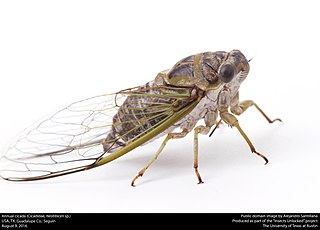
Cicadidae is the largest family of cicadas, with more than 3,200 species worldwide. The oldest known definitive fossils are from the Paleocene, a nymph from the Cretaceous Burmese amber has been attributed to the family, but could also belong to the Tettigarctidae.

Pomponia is a genus of cicadas from Asia. A group of species previously placed in Pomponia, containing the largest cicada species found on earth, have recently been moved to Megapomponia. However, the remaining species still form a very heterogeneous group and Duffels and Hayashi (2006) mentioned that several species should probably be transferred to genera like Terpnosia and Leptosemia.

The Cicadinae are a subfamily of cicadas, containing the translucent cicadas. They are robust cicadas and many have gaudy colors, but they generally lack the butterfly-like opaque wing markings found in many species of the related Tibiceninae.
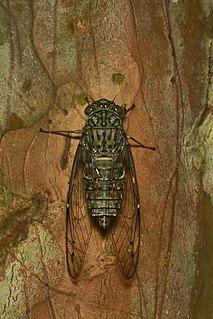
Purana is a genus of cicadas from Southeast Asia. Its distribution includes Java, Sumatra, Borneo, The Philippines, peninsular Malaysia, Thailand, India, Indochina, China, and Japan. Only one species has been recorded east of the Wallace Line, Purana celebensis, from Sulawesi. In all species the male possess two pairs of dark ventral abdominal tubercles on third and fourth sternites. The male opercula are rather short and generally do not reach beyond the posterior pair of tubercles. Related genera that also possess abdominal tubercles are Leptopsaltria, Maua, Nabalua and Tanna which together with Purana are in the subtribe Leptopsaltriina of the tribe Cicadini.

Orientopsaltria is a genus of cicadas from Southeast Asia. Its distribution encompasses the Malayan Peninsula, Sumatra, Borneo, Palawan and the Philippines.
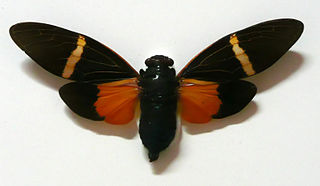
Tosena is a genus of cicadas from South-East Asia. They are the type genus of tribe Tosenini. Species formerly included in Tosena are Distantalna splendida, Formotosena montivaga, Formotosena seebohmi and Trengganua sibylla.

Megapomponia is a genus of cicadas from Southeast Asia containing the world's largest cicadas species. It was erected by Michel Boulard to accommodate the world's largest cicada species, Megapomponia imperatoria, the type species of Megapomponia. Boulard included seven species in Megapomponia. Lee and Sanborn, however, re-transferred two species to Pomponia, Pomponia decem and Pomponia rajah.
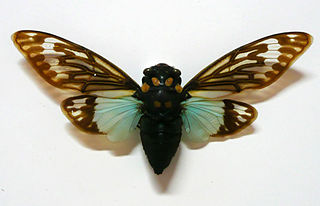
Distantalna splendida is a cicada species from Southeast Asia. It was previously placed in the genus Tosena. A characteristic that distinguishes Distantalna splendida from the Tosena species is the partly pale hyaline tegmina and wings. The species of Tosena do not have hyaline parts in the tegmina and wings. It has been recorded from India, Myanmar and Thailand.
Euterpnosia is a genus of cicada native to the island of Formosa, the Ryukyu Archipelago, Japan, Hainan and mainland Asia - China, Bhutan, Nepal and Vietnam. The type species is Euterpnosia chibensisMatsumura, 1917.

Formotosena seebohmi is a cicada species from Taiwan,China, Vietnam and Japan.
Masayo Kato was a Japanese entomologist.
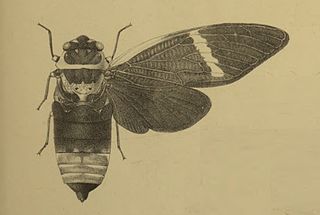
Formotosena montivaga is a cicada species from Southeast Asia that was formerly placed in the genus Tosena. It was described in 1889 by Distant from material collected in the Naga Hills which are on the border of India and Burma.

Graptopsaltria is a genus of cicadas from East Asia.

Polyneura is a cicada genus from Southeast Asia. Polyneura is a monotypic genus and the type species is Polyneura ducalis.

The Dundubiini are a tribe of cicadas in the family Cicadidae, found in the Palearctic, Indomalaya, Australasia, and the Western Pacific. There are at least 20 genera and 180 described species in Dundubiini.

Maua is a genus of cicadas from Southeast Asia. The males possess two pairs of dark ventral abdominal tubercles on third and fourth sternites.

Cryptotympana is a genus of cicadas from Southeast Asia.

Gaeana atkinsoni is a colourful cicada species and is the only member of the genus Gaeana that is found in southern India. Other species are found along the Himalayas and in Southeast Asia. It is endemic to the forests of the Western Ghats where it emerges in summer. Males are brightly coloured with a yellow and black forewing and a bright red hindwing that is visible in flight.
Becquartina is a genus of Asian cicadas in the tribe Gaeanini and the monotypic subtribe Becquartinina. This genus includes species that were previously placed in Gaeana and are sometimes known as "butterfly cicadas" due to their colourful wings.
Macrosemia is a genus of Asian cicadas in the tribe Dundubiini. Species records are from Taiwan and the eastern Asian mainland, including Indo-China.
















